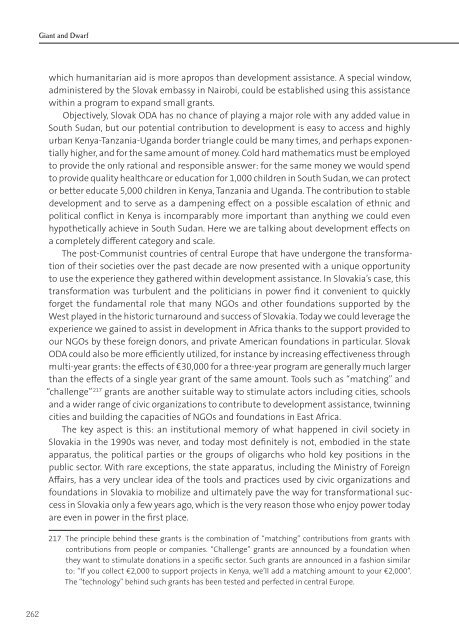Giant_and_Dwarf-FIN
Giant_and_Dwarf-FIN
Giant_and_Dwarf-FIN
Create successful ePaper yourself
Turn your PDF publications into a flip-book with our unique Google optimized e-Paper software.
<strong>Giant</strong> <strong>and</strong> <strong>Dwarf</strong>which humanitarian aid is more apropos than development assistance. A special window,administered by the Slovak embassy in Nairobi, could be established using this assistancewithin a program to exp<strong>and</strong> small grants.Objectively, Slovak ODA has no chance of playing a major role with any added value inSouth Sudan, but our potential contribution to development is easy to access <strong>and</strong> highlyurban Kenya-Tanzania-Ug<strong>and</strong>a border triangle could be many times, <strong>and</strong> perhaps exponentiallyhigher, <strong>and</strong> for the same amount of money. Cold hard mathematics must be employedto provide the only rational <strong>and</strong> responsible answer: for the same money we would spendto provide quality healthcare or education for 1,000 children in South Sudan, we can protector better educate 5,000 children in Kenya, Tanzania <strong>and</strong> Ug<strong>and</strong>a. The contribution to stabledevelopment <strong>and</strong> to serve as a dampening effect on a possible escalation of ethnic <strong>and</strong>political conflict in Kenya is incomparably more important than anything we could evenhypothetically achieve in South Sudan. Here we are talking about development effects ona completely different category <strong>and</strong> scale.The post-Communist countries of central Europe that have undergone the transformationof their societies over the past decade are now presented with a unique opportunityto use the experience they gathered within development assistance. In Slovakia’s case, thistransformation was turbulent <strong>and</strong> the politicians in power find it convenient to quicklyforget the fundamental role that many NGOs <strong>and</strong> other foundations supported by theWest played in the historic turnaround <strong>and</strong> success of Slovakia. Today we could leverage theexperience we gained to assist in development in Africa thanks to the support provided toour NGOs by these foreign donors, <strong>and</strong> private American foundations in particular. SlovakODA could also be more efficiently utilized, for instance by increasing effectiveness throughmulti-year grants: the effects of €30,000 for a three-year program are generally much largerthan the effects of a single year grant of the same amount. Tools such as “matching” <strong>and</strong>“challenge” 217 grants are another suitable way to stimulate actors including cities, schools<strong>and</strong> a wider range of civic organizations to contribute to development assistance, twinningcities <strong>and</strong> building the capacities of NGOs <strong>and</strong> foundations in East Africa.The key aspect is this: an institutional memory of what happened in civil society inSlovakia in the 1990s was never, <strong>and</strong> today most definitely is not, embodied in the stateapparatus, the political parties or the groups of oligarchs who hold key positions in thepublic sector. With rare exceptions, the state apparatus, including the Ministry of ForeignAffairs, has a very unclear idea of the tools <strong>and</strong> practices used by civic organizations <strong>and</strong>foundations in Slovakia to mobilize <strong>and</strong> ultimately pave the way for transformational successin Slovakia only a few years ago, which is the very reason those who enjoy power todayare even in power in the first place.217 The principle behind these grants is the combination of “matching” contributions from grants withcontributions from people or companies. “Challenge” grants are announced by a foundation whenthey want to stimulate donations in a specific sector. Such grants are announced in a fashion similarto: “If you collect €2,000 to support projects in Kenya, we’ll add a matching amount to your €2,000”.The “technology” behind such grants has been tested <strong>and</strong> perfected in central Europe.262


